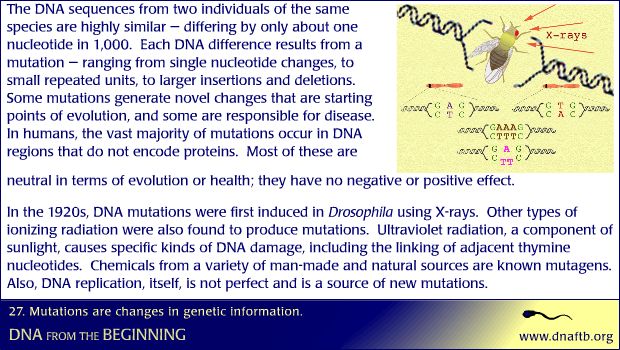Concept 27: Mutations are changes in genetic information.

Some mutations are starting points for evolution, others are responsible for disease.
The DNA sequences from two individuals of the same species are highly similar — differing by only about one nucleotide in 1,000. Each DNA difference results from a mutation — ranging from single nucleotide changes, to small repeated units, to larger insertions and deletions. Some mutations generate novel changes that are starting points of evolution, and some are responsible for disease. In humans, the vast majority of mutations occur in DNA regions that do not encode proteins. Most of these are neutral in terms of evolution or health; they have no negative or positive effect. In the 1920s, DNA mutations were first induced in Drosophila using X-rays. Other types of ionizing radiation were also found to produce mutations. Ultraviolet radiation, a component of sunlight, causes specific kinds of DNA damage, including the linking of adjacent thymine nucleotides. Chemicals from a variety of man-made and natural sources are known mutagens. Also, DNA replication, itself, is not perfect and is a source of new mutations. Â
dna mutations, types of ionizing radiation, dna replication, nucleotide changes, dna sequences, dna damage, ultraviolet radiation, thymine, genetic information, insertions, deletions, mutation, proteins, sunlight, chemicals, evolution
- ID: 16587
- Source: DNALC.DNAFTB
Related Content
15529. Radiation can cause DNA mutations, 3D animation with narration
Mutations and the molecular clock.
16492. Problem 21: RNA is an intermediary between DNA and protein.
What happens in protein synthesis?
16612. Concept 28: Some types of mutations are automatically repaired.
DNA repair is central to survival.
16621. Video 28: Jane Setlow, clip 1
The significance of understanding mutation repair systems.
15681. DNA nucleotides represented as wooden tiles
Changes in the DNA are reflected in the protein product. There is a correlation between what happens to the genetic sequence and the resulting protein sequence.
15617. DNA nucleotide mutation
A single DNA nucleotide undergoes a "point" mutation, changing an A to a T.
16588. Animation 27: Mutations are changes in genetic information.
Herman Muller induces fruit fly mutations. Seymour Benzer works with virus mutants ans proved only one nucleotide change can cause mutation.
16625. Problem 28: Some types of mutations are automatically repaired.
Learn how the cause of Xeroderma pigmentosum is caused by a defect in a DNA repair system.
16624. Biography 28: Richard B. Setlow (1921–2015)
Richard Setlow did a lot of the early work on thymine dimer repair.
16613. Animation 28: Some types of mutations are automatically repaired.
Stan Rupert explains UV damage and light-activated DNA repair systems and Richard Setlow's work on thymine dimer repair.












